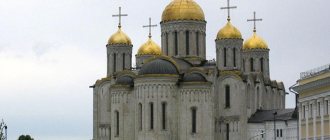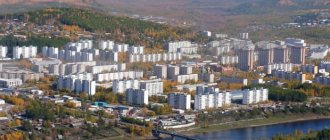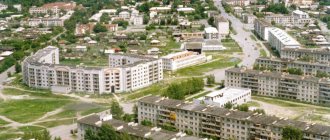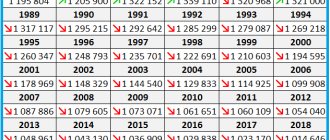City in Sverdlovsk Oblast, Russia
City in Sverdlovsk Oblast, Russia
| Sredneuralsk Sredneuralsk | |
| Town[1] | |
| Flag Coat of arms | |
| Location of Sredneuralsk | |
| Sredneuralsk Location of Sredneuralsk Show map of Russia Sredneuralsk Sredneuralsk (Sverdlovsk region) Show map of Sverdlovsk region | |
| Coordinates: 56°59'N 60°28'E / 56.983°N Latitude 60.467°E / 56.983; 60.467Coordinates: 56°59'N 60°28'E / 56.983°N 60.467°E / 56.983; 60.467 | |
| A country | Russia |
| Federal subject | Sverdlovsk region[1] |
| Based | June 27, 1931 |
| City status from | February 17, 1966 |
| Government | |
| • Mayor | Alexey Danilov |
| Height | 270 m (890 ft) |
| population (2010 Census)[2] | |
| • General | 20,449 |
| • Evaluate (2018)[3] | 23,353 (+14.2%) |
| Administrative status | |
| • Subordinate | Town of Verkhnyaya Pyshma[1] |
| Municipal status | |
| • Urban district | Sredeuralsk urban district[4] |
| • Capital from | Sredeuralsky urban district[4] |
| Timezone | UTC + 5 (MSK + 2 [5]) |
| Postal code(s)[6] | 624070, 624071 |
| Dial code(s) | +7 34368 |
| OKTMO I WOULD | 65757000001 |
| Web site | Sredneuralsk.RU |
Sredneuralsk
(Russian: Sredneuralsk) is a town under the administrative jurisdiction of Gorodok of Verkhnyaya Pyshma in Sverdlovsk Oblast, Russia, located on the shore of Lake Isetskoe, at the head of the Iset River, 25 km (16 mi) north of Yekaterinburg. Population: 20,449 (2010 Census);[2] 19,555 (2002 Census);[7]18,786 (1989 Census).[8]
Climate
The climate of Sredneuralsk is unusual. continental. The average temperature range is from -45 °C (-49 °F) to +38 °C (100 °F). Average January temperature is -16 °C (3 °F); in July: +17.4 °C (63.3 °F). Snow cover usually remains on the surface for up to five months from November to mid-April. Average annual precipitation is 430–500 millimeters (17–20 in). The city lies at 252–278 meters (827–912 ft). above sea level.
The main components of rocky soil are: granite and shales.
Geography[ | ]
The urban district of Sredneuralsk is located in the southwestern part of the Sverdlovsk region, in the northeastern part of the Western administrative district as part of the region. The area of the urban district is 83.98 km²[4], which is approximately 0.043% of the total area of the region.
The urban district is the city of Sredneuralsk with its suburban area. Sredneuralsk is located on the shores of Lake Isetskoe, most of which is concentrated within the boundaries of the urban district.[7]
The city's transport networks consist mainly of roads inside Sredneuralsk and other settlements of the district, as well as access roads to the city and the village of Murzinka from the Serovsky tract. The Sredneuralsk-Koptyaki-Iset highway also runs along the southern shore of Lake Iset. In the very south of the urban district there are small sections of the railway, the Yekaterinburg ring road and the Shuvakish-Gat road, but they are not road networks of the urban district and serve only as transit roads. Next to the railway there is a small railway park belonging to the Yekaterinburg-Sortirovochny station, in which cars are parked. From the south of the urban district there is also a single-track industrial railway line from the Shuvakish station to the city.[7]
In the north of the urban district and the city there is the Sredneuralskaya State District Power Plant.
The Mulyanka River flows through the southern part of the district, flowing into Lake Isetskoe[8].
On three sides, the urban district of Sredneuralsk is surrounded by the territory of the urban district of Verkhnyaya Pyshma, in the south it borders with the municipal formation “city of Yekaterinburg”.[7]
Economy
CHPP "SUGRES" is based in Sredneuralsk. The station was officially opened on June 27, 1931. Other industrial plants include:
- Sredneuralsky Metallurgical Plant (founded in 1941)
- Sredneuralsky Precast Concrete Plant (founded in 1964)
- Sredneuralsk Housing and Construction Enterprise (founded in 1966)
- Sredneuralsk Railway Transport Enterprise (founded in 1975)
- Winery (founded 1960)
- Poultry farm (founded in 1973)
Transport
The city is connected to a major bus route. The length of the route from Sredneuralsk to Yekaterinburg is 25 kilometers (16 miles).
History of local government of the city of Sredneuralsk
Home / Publications / History of local government of the city of Sredneuralsk
July 14, 2013
Publications
Local self-government in the Soviet period.
The city of Sredneuralsk was born during the Soviet period, when the basis for the organization of power was the principle of the unity of the Soviet system as bodies of state power from top to bottom. During that historical period, local self-government was rejected. This changed the ideas about local self-government as self-government of the population that existed before the revolution. In other words, local self-government in the form of Councils of People's Deputies actually began to represent the lower level of the unified state apparatus.
Firstly, local Councils were bodies of power and control operating within the boundaries of the then existing administrative territories.
Secondly, there was an organizational relationship and vertical subordination. And finally, when determining the competence and limits of authority of local Councils, their independence in resolving issues of local importance was established, but their activities were allowed only in accordance with the decisions of the central government and higher Councils.
In the workers' village of Sredneuralsk, on June 10, 1932, the Middle Ural Village Council was formed, with the inclusion of the village of Koptyaki, the Koptyakovsky Village Council, annexed to the Sverdlovsk City Council, which was part of the Stalin District Sverdlovsk City Council of Workers' Deputies of the Sverdlovsk Region.
In 1934 , the first deputies of the SUGRES village council were elected. It included 50 people. Most of these are people of working professions: storekeeper, fisherman, mechanic, housewife, digger, horse hauler, fitter, stoker, storekeeper, mosaicist - plasterer, foreman, etc. There were also representatives from the management: director of SUGRES, director of the club, engineer of the technical department, head. nursery, criminal investigation commissioner, electric shop foreman, brick factory foreman, teacher at school No. 26, etc.
At the beginning of the convening of the Sredneuralsk Village Council of Workers, the number of deputies was different: in 1939, 25 deputies were elected; in 1961 - 75 people, in 1985 - 19 convocation, 65 deputies were elected.
The Sredne-Uralsky Village Council performed the functions of a village council until February 17, 1966, when, by Decree of the Presidium of the Supreme Soviet of the USSR RSFSR No. 9 of March 2, 1966, the working village of Sredne-Uralsk was transformed into a city of regional subordination. And the Middle Ural Village Council was transformed into the Middle Ural City Council of Workers' Deputies with subordination to the Verkhnepyshma City Council of Workers' Deputies.
The structure of the Council has changed and expanded. If the village Council had a chairman, secretary and accounting department, then the city Council introduced a deputy position. Accounting became centralized; it served educational institutions and the city council. On April 1, 1968, city hospital No. 2 and secondary school No. 5. A registry office and a military registration office appeared in the city. IN
In connection with the adoption of the new Constitution of the USSR in 1977 and changes in legislation, on October 7, 1977, the Council was renamed the Sredneuralsk City Council of People's Deputies.
The most important issues in the life of the village were resolved during the sessions of the Soviets, where permanent commissions were elected to oversee issues of public services, agriculture, health care, culture and a number of others.
In Sredneuralsk there were permanent commissions: on public education and culture, on health care and social welfare, on youth affairs, on socialist legality and the protection of public order, on trade and public catering, on agriculture, on construction, landscaping and nature conservation, on household service
For issues of daily management and coordination of the city's activities, the Executive Committee of the Sredneuralsk City Council - City Executive Committee, which was headed by the chairman, was elected.
The idea of local self-government was returned to in the late 1980s, in connection with the reform of state power in the country.
Local government system in the 80s. was characterized as follows. Local Soviets were supposed to manage state, economic and socio-cultural construction on their territory; approve economic and social development plans and the local budget; exercise management of government bodies, enterprises, institutions and organizations subordinate to them; ensure compliance with laws, protection of state and public order, and citizens' rights; contribute to strengthening the country's defense capability.
Within the limits of its powers, the city Council of People's Deputies of Sredneuralsk had to:
- ensure comprehensive economic and social development in the territory;
- exercise control over compliance with the legislation of enterprises, institutions and organizations located in the city;
- coordinate and control their activities in the field of land use, nature conservation, construction, use of labor resources, production of consumer goods, socio-cultural, consumer and other services to the population.
The exclusive competence of the City Council included:
- election and change of composition of the executive committee;
- formation, election and change of composition of standing committees of the Council, hearing reports on the work of executive committees and standing commissions.
In the second half of the 80s. The view gradually began to be established that local self-government is an independent level of exercise by the people of the power constitutionally belonging to them, that a democratic structure of society is possible only with the separation of local self-government from state power.
Local self-government of Russia in the transition period
The first practical step in reforming local government, introducing a new approach to it as local self-government for modern Russia, was the adoption and implementation of the USSR Law “On the General Principles of Local Self-Government and Local Economy in the USSR” (1990), the RSFSR Law “On Local Self-Government” (1991). The adopted laws played a big role in the formation of local self-government. Powers were delineated between local councils and administrations.
Executive committees throughout the country were eliminated. By decision of the Sredneuralsk City Council of August 16, 1990
The executive committees of local Soviets were replaced by the concept of “local administration”. She was accountable to local councils and higher executive and administrative bodies. But the fundamental innovation was that the local administration was no longer a body of the corresponding local Council, unlike the previous executive committees, which, although they were actually independent of the Councils, were legally considered their executive and administrative bodies.
The formation of local self-government was accompanied by a transition from the executive committee-collegial form of executive activity to the principle of unity of command in the management of the local executive apparatus.
The city administration was accountable to the Presidium of the City Council of People's Deputies and was headed by a head who exercised his powers on the principles of unity of command.
In accordance with the Law of the RSFSR “On elections to local Councils of People's Deputies of the RSFSR,” elections were held in Sredneuralsk in March 1990. 50 electoral districts were formed, 53 candidates were nominated, of which 40 people’s deputies were elected (18 people with higher education, 47 with secondary specialized education). Repeat elections were held in 10 constituencies in April due to the fact that in these constituencies the candidates did not receive a majority of votes.
The final number of people's representatives was 65 people, from among their deputies at the first meeting, the chairman of the Sredneuralsk City Council was elected by secret ballot. Permanent commissions were formed.
At the meetings of the Sredneuralsk City Council of People's Deputies of the second session of the 21st convocation, the Presidium was created as a body executing the decisions of the City Council (decision dated August 16, 1990).
The RSFSR Law of July 6, 1991 “On Local Self-Government in the RSFSR” included local administration in the system of local self-government and called them representative authorities without the word “state” (Article 1, Part 1).
The law provided for the division of functions between representative and executive bodies. The City Council was defined as the authority, and the local administration as the governing body. At the same time, the independence of the latter increased. And instead of the executive committee of the local Council as a collegial body subordinate and accountable to the Council, a local administration was established under the sole leadership of the head of the administration, elected by the population. The administration's own competence was established, which weakened its responsibility to higher executive and administrative bodies and the local Council.
The City Council was proclaimed as the main body of local self-government; it had many opportunities to influence the administration, but in fact the administration received significant independence.
Resolution of the Congress of People's Deputies of the RSFSR dated November 1, 1991 On the organization of executive power during the period of radical economic reform", Decree of the President of the RSFSR No. 239 dated November 25, 1991 "On the procedure for appointing heads of administrations", Resolution of the head of the administration of the city of Verkhnyaya Pyshma No. 25 of December 21, 1991. On December 21, 1991, the Administration of the city of Sredneuralsk was formed. The Head of Administration of the city of Sredneuralsk was appointed for the first time. The structure of the administration consisted of: the head, two deputies, a secretary-typist, inspectors of the military registration desk and the registry office.
In December 1991, the city administration was headed by the head (V.P. Tsypnyatov). In this regard, his parliamentary powers were terminated and he was prematurely released from his position as chairman of the city Council of People's Deputies. The representative body of government in the city was the Sredneuralsk City Council of People's Deputies, elected by citizens.
In 1991, according to the Decision of the Presidium of the Sredneuralsk City Council of People’s Deputies of the sixth session of the Sredneuralsk City Council of the 21st convocation dated December 13, 1991 “On the election of the Small Council”, the Small Council of the Sredneuralsk City Council of People’s Deputies was elected from among the deputies by open voting, which exercised the powers of a representative body in the territory of Sredneuralsk during the period between sessions of the City Council and was accountable to it. The Small Council consisted of five deputies.
A new stage in the formation and development of local self-government in Russia, truly modern municipal government, began in the country in 1993.
The Constitution of the Russian Federation, adopted on December 12, 1993, enshrined local self-government and its independence, including in determining the structure of local government bodies. Later, in 1997 and 2000, significant amendments were adopted to it on local self-government in cities of federal significance and on the responsibility of local government bodies and their officials.
The Regulations on the Fundamentals of the Organization of Local Self-Government in the Russian Federation for the period of phased constitutional reform provided that in the system of local self-government, in urban settlements with a population of up to 50 thousand people, such as our city, an elected meeting of representatives is elected - the Assembly of Elected People and an elected head of the local self-government, he is also the head of the administration.
Local government in the city represented a system of organizing the activities of citizens in the interests of the population. Carried out through the Central Urals City Council of People's Deputies and the city administration
In 1993, Decree of the President of the Russian Federation dated October 9, 1993 No. 1617 “On the reform of representative authorities and local governments in the Russian Federation” was issued. By this Decree, until the election of new bodies of representative power, the executive and administrative functions assigned to the Councils of People's Deputies are carried out by the administration.
By decision of the Small Council, “...deputies of all convocations were expressed gratitude for their conscientious attitude towards their responsibilities for the social and industrial development of the city of Sredneuralsk, and from October 9, 1993, the activities of deputies of the last 21st convocation of the Council were terminated.”
All powers of the Sredneuralsk City Council were transferred to the administration of the city of Sredneuralsk. The Decree of the President of the Russian Federation of December 22, 1993 “On guarantees of local self-government in the Russian Federation” established, in essence, the temporary priority of the administration in its relations with the representative body of local self-government.
Between 1991 and 1995 The executive and administrative body of local self-government of the city of Sredneuralsk was the Administration, subordinate to the Administration of the city of Verkhnyaya Pyshma.
In 1993 , during the period of gradual constitutional reform, local government reform was carried out. The activities of the Sredneuralsk City Council were terminated, administrative powers were transferred to local administrations, and the elections of new representative bodies of local government were postponed until 1994.
On April 10, 1994, elections were held for the Head of local government of the city of Sredneuralsk and representatives to the Sredneuralsk City Assembly of Elected People. In 5 districts, 11 candidates were registered and 5 representatives were elected. The head of local government was elected.
In the 90s Basically, the organizational and legal foundations of local self-government in Russia were created. However, despite this, the local government system functioning in the country was still far from its constitutional model. Although the regulatory framework and the complex of organizational measures taken confirm the fact of Russia’s transition to an autonomous model of local self-government, the legacy of the previously operating system of “local Councils” continues to be the economic dependence of local governments on higher government bodies.
In 1995, the head of local government and the representative body of the city of Sredneuralsk - the Sredneuralsk City Assembly of Elected People, guided by the current legislation, decided to create an independent municipal entity "city of Sredneuralsk".
By the decision of the Assembly of Elected People on November 23, 1995, the first Charter of the Municipal Formation “city of Sredneuralsk” was adopted.
The municipal formation “city of Sredneuralsk” was included in the regional register of municipal formations on November 10, 1996
In 1996, the Administration of the city of Sredneuralsk was renamed into the Administration of the Municipal Formation “City of Sredneuralsk”. The head of the administration received the status of Head of local government.
The Administration of the Municipal Formation “City of Sredneuralsk” is the executive and administrative body of local government on the territory of the Municipal Formation and is the successor to the Administration of the City of Sredneuralsk. The administration is accountable to the Head of the municipality and the Duma within its competence.
According to Resolution of the Sverdlovsk Regional Duma No. 354 of January 18, 1996, elections to the representative body of local self-government - the Sredneuralsk City Duma were scheduled for April 14, 1996, and the Meeting of Elected People, in accordance with the City Charter, appointed elections for the Head of local government of the city of Sredneuralsk. Based on the election results, 10 (ten) deputies were registered, and the head of the municipality was elected. On April 25, 1996, the first meeting of the Sredneuralsk City Duma of the first convocation took place.
By decision of the Sredneuralsk City Duma of the first convocation, elections of deputies of the Sredneuralsk City Duma were scheduled for March 26, 2000, and in order to coincide with the voting day, elections for the head were scheduled. To conduct elections of deputies of the Sredneuralsk City Duma of the second convocation, two multi-member electoral districts were formed with the number of mandates to be distributed in each district - 5 (five). 20 candidates were nominated.
In accordance with the decision of the Sredneuralsk City Election Commission, based on the election results, 10 deputies and the head of local government were recognized as elected. The 2000 elections consolidated these positions and confirmed that the population as a whole took and continues to take a fairly active part in the formation of municipal bodies.
On March 14, 2004, elections to local government bodies were held, based on the results of which 15 (fifteen) deputies of the Sredneuralsk City Duma of the third convocation were elected, and the head of the municipality was elected.
The last reform of local self-government took place in 2006 in connection with the adoption of the Federal Law “On the General Principles of the Organization of Local Self-Government in the Russian Federation” (No. 131-FZ of October 6, 2003).
The main goal of the Federal Law is to eliminate uncertainties in the delimitation of jurisdiction and powers between state authorities and local governments. Among the main tasks of local government reform are: interbudgetary and property relations; strengthening the administrative and civil responsibility of municipal authorities; determination of municipal boundaries; involving the population in active participation in the activities of local government.
On January 1, 2006, the municipal formation “city of Sredneuralsk” received the status of an urban district. The Administration of the Municipal Formation "City of Sredneuralsk" was renamed into the Administration of the Urban District of Sredneuralsk, which carries out organizational, executive and administrative functions. The administration, on the principles of unity of command, is headed by the Head of the Sredneuralsk urban district - the highest elected official. The representative body of local self-government is the Duma of the city district of Sredneuralsk, consisting of 15 people.
On March 2, 2008, 48 candidates for deputies were registered in three electoral districts. According to the decision of the Sredneuralsk city territorial election commission, 15 (fifteen) deputies of the Duma of the Sredneuralsk city district of the fourth convocation were recognized as elected.
On March 4, 2011, elections were held to the Duma of the city district of Sredneuralsk of the fifth convocation, 15 deputies were elected.
Local government is one of the most important institutions of modern society. Today it is both a form of self-organization of citizens and - in this capacity - an integral part of civil society, a level of public power, an instrument for the democratic participation of citizens in the management of common affairs and an element of a market economic system.
During its short life, Sredneuralsk, along with the whole country, has experienced many reforms. The modern system of local self-government is developing, changing, and improving. There are certain achievements - the city has become independent, having its own budget, the ability to direct it to the priority needs of the city. A local government body in which city residents directly participate. But today, as before, local governments have many problems, issues that require enormous efforts, painstaking and hard work.
Director
MKU "Archive of the urban district of Sredneuralsk" E.V. Plato
July 2013
Share:
Recent publications in this category
September 18, 2022 And makes history transparent in order to discern the future in the past, dedicated to the 100th anniversary of the Archival Service of the Sverdlovsk Region
November 20, 2022 History of modern Russian elections
May 31, 2022 Keepers of History. 100th anniversary of the Russian State Archive Service
August 6, 2022 The Council of Veterans of Sredneuralsk is 50 years old
April 20, 2022 Head of the city of Sredneuralsk
October 14, 2015 Sesquicentennial anniversary of the Sredneuralsk Maternity Hospital
April 8, 2014 Meeting of Elects - 20 years later
August 18, 2012 Deputies of Sredneuralsk of the first to fifth convocations 1996-2011
May 15, 2012 History of the Sredneuralsk Council and its reorganization
April 6, 2011 60th anniversary of the Sredneuralsk city police department
Composition of the urban district[ | ]
| № | Locality | Type of settlement | Population |
| 1 | Brick | village | ↗67[12] |
| 2 | Koptyaks | village | ↗217[12] |
| 3 | Murzinka | village | ↗38[12] |
| 4 | Sredneuralsk | city, administrative center | ↗23 889[5] |
From the point of view of the administrative-territorial structure of the region, all 4 settlements of the urban district of Sredneuralsk are part of the “city of Verkhnyaya Pyshma”.
Population[ | ]
| Population | ||||||
| 2010[12] | 2011[13] | 2012[14] | 2013[15] | 2014[16] | 2015[17] | 2016[18] |
| 20 771 | ↗20 804 | ↗21 069 | ↗21 434 | ↗21 706 | ↗22 383 | ↗23 087 |
| 2017[19] | 2018[20] | 2019[21] | 2020[22] | 2021[5] | ||
| ↗23 479 | ↗24 011 | ↗24 300 | ↗24 414 | ↗24 651 | ||








